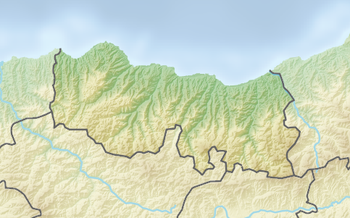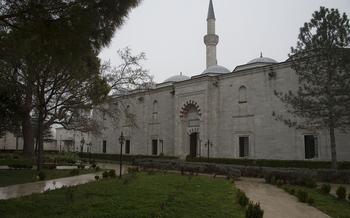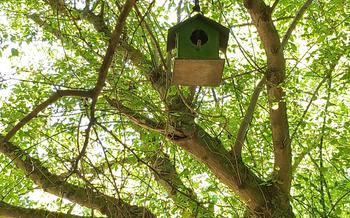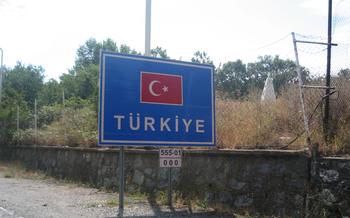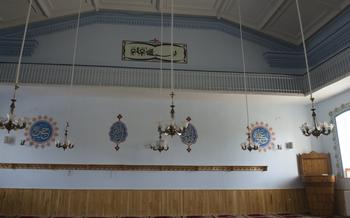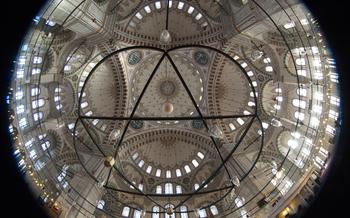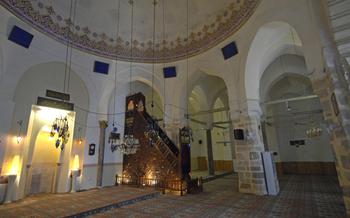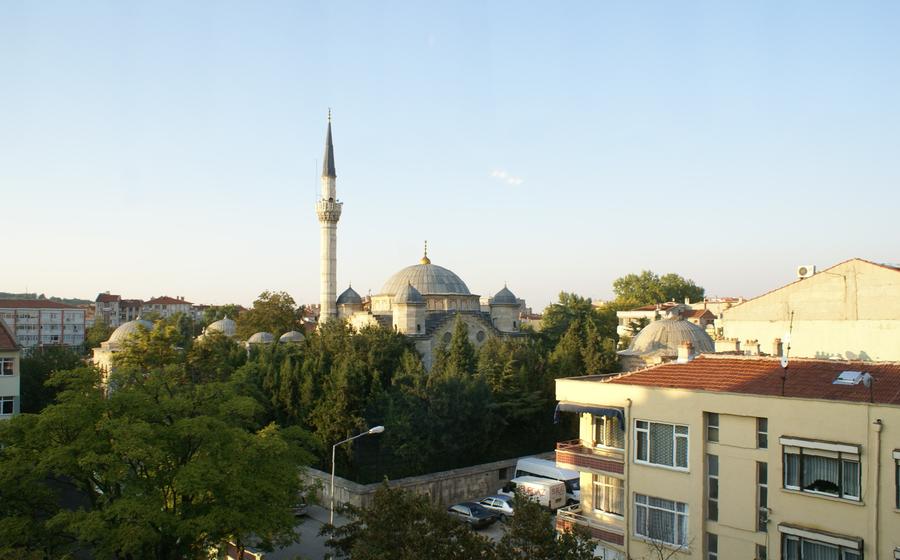
Sokullu Mehmet Pasha Mosque
- History of the Sokullu Mehmet Pasha Mosque
- Architectural Features
- Significance of the Mosque
- Location and Accessibility
- Visiting Hours and Admission Fees
- Dress Code and Etiquette
- Things to See Inside the Sokullu Mehmet Pasha Mosque
- Things to Do Nearby
- Photography and Videography
- Guided Tours
- Accessibility for Disabled Visitors
- Local Customs and Traditions
- Safety Tips
- Best Time to Visit
- Insider Tip: Uncover the Hidden Gem of Kırklareli
History of the Sokullu Mehmet Pasha Mosque
Constructed during the flourishing reign of the Ottoman Empire, the Sokullu Mehmet Pasha Mosque stands as a testament to the empire's architectural prowess and cultural legacy. Commissioned by the Grand Vizier, Sokullu Mehmet Pasha, this magnificent mosque was built between 1569 and 1575 under the watchful eye of the renowned architect, Mimar Sinan. Sinan's legacy as one of the greatest Ottoman architects is further solidified by this masterpiece, which bears his signature blend of technical ingenuity and aesthetic splendor.
Sokullu Mehmet Pasha himself, a prominent figure in the Ottoman court, served as Grand Vizier to three sultans, namely Süleyman the Magnificent, Selim II, and Murad III. His influence and dedication to the empire are reflected in the scale and grandeur of the mosque that bears his name, which has become a symbol of his lasting contributions to the Ottoman Empire.
Architectural Features
The Sokullu Mehmet Pasha Mosque stands as a testament to the grandeur and artistry of Ottoman architecture. Its unique architectural style blends elements of both Byzantine and Islamic design, creating a harmonious fusion of styles. The mosque's exterior is adorned with intricate carvings and tilework, showcasing the exceptional craftsmanship of its builders. The main entrance boasts an impressive portico supported by elegant columns, inviting visitors into the sacred space within.
Inside, the mosque's interior design is equally captivating. The spacious prayer hall is adorned with a stunning dome, intricate arches, and vibrant tilework. The mihrab, or prayer niche, is a masterpiece of craftsmanship, featuring intricate carvings and colorful tiles that draw the eye. The mosque's interior is flooded with natural light, thanks to its many windows, creating a serene and uplifting atmosphere for worship and contemplation.
Significance of the Mosque
The Sokullu Mehmet Pasha Mosque holds immense significance in the history and culture of Turkey. During the Ottoman Empire, it served as a crucial religious center and a symbol of the empire's architectural prowess. The mosque's intricate design, incorporating both Islamic and Byzantine elements, reflected the Ottoman's commitment to blending diverse cultural influences.
As a cultural and historical landmark, the mosque stands as a testament to the architectural genius of Mimar Sinan and the patronage of Grand Vizier Sokullu Mehmet Pasha. Its unique features, such as the cascading domes and graceful minarets, have earned it recognition as a masterpiece of Islamic architecture. The mosque's well-preserved condition also makes it a valuable source of information for historians and architects studying the evolution of Ottoman architecture.
Beyond its architectural significance, the Sokullu Mehmet Pasha Mosque has played a crucial role in shaping Turkish society. As a religious center, it has fostered a sense of community among Muslim worshippers and served as a venue for important religious ceremonies. The mosque's association with the Ottoman Empire has also imbued it with a sense of national pride and heritage for the Turkish people.
In recognition of its outstanding universal value, UNESCO inscribed the Sokullu Mehmet Pasha Mosque on the World Heritage List in 20This prestigious designation further underscores the mosque's significance as a cultural and historical treasure of global importance.
Location and Accessibility
The Sokullu Mehmet Pasha Mosque is situated in the heart of Kırklareli, at the address: Cumhuriyet Mahallesi, Hürriyet Caddesi, No: 28, 39000 Kırklareli Merkez/Kırklareli. Its prominent location makes it easily accessible by various modes of transportation.
For those traveling by public transport, the mosque is conveniently located within walking distance from the Kırklareli Bus Terminal. Several bus lines stop nearby, providing easy access from different parts of the city.
For visitors arriving by private vehicle, there are ample parking options available in the vicinity of the mosque. Designated parking spaces for visitors can be found along the streets surrounding the mosque, ensuring a hassle-free parking experience.
When navigating the area around the mosque, visitors should be mindful of the narrow streets and pedestrian-friendly zones. Walking is often the most convenient way to explore the historic center of Kırklareli, allowing visitors to soak in the ambiance and admire the surrounding architecture.
Visiting Hours and Admission Fees
The Sokullu Mehmet Pasha Mosque welcomes visitors from all over the world to explore its architectural wonders and historical significance. Its doors are open to the public during specific hours, allowing tourists to immerse themselves in the mosque's spiritual and cultural atmosphere.
Visiting Hours:
- Summer Season (April-October):
- Weekdays: 9:00 AM - 6:00 PM
-
Weekends: 10:00 AM - 6:00 PM
-
Winter Season (November-March):
- Weekdays: 9:00 AM - 5:00 PM
- Weekends: 10:00 AM - 5:00 PM
The mosque remains closed during prayer times, which typically occur five times a day. Visitors are advised to plan their visit accordingly to avoid any inconvenience.
Admission Fees:
- Entrance to the mosque is free of charge. This open-door policy allows everyone to experience the beauty and spirituality of this historic monument without any financial barriers.
Discounts and Concessions:
- Free guided tours are available for groups upon reservation. These tours provide an in-depth exploration of the mosque's history, architecture, and cultural significance.
- Students and senior citizens may be eligible for discounted admission fees. Proper identification is required to avail of these concessions.
Dress Code and Etiquette
For many, a mosque is a sacred place of worship and visitors are expected to dress and behave respectfully. When visiting the Sokullu Mehmet Pasha Mosque, modest attire is recommended. For men, this means covering their knees and shoulders, while women should cover their hair, arms, and legs. Avoid wearing anything too revealing or tight-fitting.
Upon entering the mosque, remove your shoes and place them in the designated racks. It's customary to walk barefoot or in socks inside the prayer hall. Maintain a quiet and respectful demeanor, avoiding loud conversations or disruptive behavior. If you need to take photos, ask permission from the mosque staff or other visitors, and be mindful of not disturbing those in prayer.
Things to See Inside the Sokullu Mehmet Pasha Mosque
The interior of the Sokullu Mehmet Pasha Mosque is just as impressive as its exterior. The main prayer hall is a vast and awe-inspiring space, with a high, domed ceiling and intricate tilework covering the walls and floor. The mihrab, or prayer niche, is particularly beautiful, with its delicate carvings and inlaid tiles.
The courtyard of the mosque is also worth exploring. It is surrounded by a covered walkway, which provides shade and shelter from the sun. The courtyard is also home to a number of fountains, which provide a welcome respite from the heat.
Other notable areas within the mosque complex include the madrasa, or religious school, and the türbe, or tomb, of Sokullu Mehmet Pasha. The madrasa is a large, two-story building with a number of classrooms and a library. The türbe is a small, octagonal building with a domed roof. It is decorated with tiles and inscriptions, and it contains the sarcophagus of Sokullu Mehmet Pasha.
Keep an eye out for the unique and hidden details throughout the mosque complex. These include the intricate carvings on the wooden doors, the beautiful stained glass windows, and the colorful carpets that cover the floors.
Things to Do Nearby
For a well-rounded cultural experience in Kırklareli, venture beyond the Sokullu Mehmet Pasha Mosque and explore other historical sites and attractions. Immerse yourself in the town's rich past at the Kırklareli Museum, showcasing artifacts and exhibits that tell the story of the region's heritage.
Stroll through the charming streets and discover hidden gems like the Old Town, where you can admire traditional Ottoman-era houses and shops. Take a break and savor the local cuisine at one of the many restaurants or cafes, indulging in delectable Turkish delights and aromatic coffee.
For those seeking unique souvenirs, explore the vibrant local markets, where you can find everything from handcrafted textiles to authentic spices. Embrace the opportunity to interact with friendly locals and learn about their customs and traditions, creating a truly memorable and immersive experience.
Photography and Videography
Photography and videography are generally permitted within the Sokullu Mehmet Pasha Mosque, allowing visitors to capture the intricate details and beauty of this historic landmark. However, it's essential to respect the sanctity of the mosque and follow certain guidelines. Flash photography and tripods are not allowed, as they can be disruptive to worshippers and damage the delicate interior. Additionally, visitors are requested to be mindful of their surroundings and avoid taking photos or videos that may disturb others' prayers or private moments.
To capture the best shots of the mosque, head to the courtyard, where you can photograph the impressive facade and minarets against the blue sky. The interior of the mosque offers equally stunning photo opportunities, with its intricate tilework, stained glass windows, and elegant chandeliers. Look for unique details such as the mihrab (prayer niche) and the minbar (pulpit), which are adorned with intricate carvings and calligraphy.
When taking photos or videos, remember to be respectful and considerate of the worshippers and other visitors. Avoid blocking their view or interrupting their prayers. It's also important to maintain silence and refrain from using flash or any other disruptive equipment. By following these guidelines, you can capture memorable images of your visit to the Sokullu Mehmet Pasha Mosque while respecting its sacred atmosphere.
Guided Tours
For a more in-depth understanding of the mosque's history, architecture, and cultural significance, consider booking a guided tour. Tours are available in various languages and provide a comprehensive overview of the site. Knowledgeable guides will lead you through the mosque, explaining its intricate details, symbolism, and role in Turkish society.
Guided tours typically cover the mosque's history, from its construction to its present-day status as a UNESCO World Heritage Site. They also delve into the architectural features, highlighting the unique elements that set the mosque apart. Visitors will learn about the mosque's cultural significance, its role in the Ottoman Empire, and its impact on Turkish society.
To book a guided tour, inquire at the mosque's information desk or contact local tour operators. Tours are usually offered at specific times throughout the day, so it's best to plan accordingly. The cost of a guided tour may vary depending on the language and duration of the tour.
Taking a guided tour is an excellent way to gain a deeper appreciation for the Sokullu Mehmet Pasha Mosque. With the help of an experienced guide, you'll uncover the hidden stories and symbolism that make this mosque a true masterpiece of Islamic architecture.
Accessibility for Disabled Visitors
The Sokullu Mehmet Pasha Mosque is committed to ensuring accessibility for visitors with disabilities. Wheelchair ramps and designated parking spaces are available for the convenience of visitors with limited mobility. The mosque's staff is also trained to assist visitors with disabilities, providing guidance and support as needed.
Although the mosque has made significant efforts to accommodate visitors with disabilities, there are still some areas that may present challenges. The courtyard, for example, is partially cobbled, which may make it difficult for wheelchair users to navigate. Visitors with visual impairments may also require assistance to fully appreciate the mosque's intricate architecture and decorations.
Despite these minor challenges, the Sokullu Mehmet Pasha Mosque welcomes visitors of all abilities and encourages everyone to experience its rich history and cultural significance. Visitors with disabilities are advised to contact the mosque in advance to inquire about any specific accommodations or assistance they may require.
Local Customs and Traditions
When visiting the Sokullu Mehmet Pasha Mosque, it's essential to be mindful of local customs and traditions to ensure a respectful and enjoyable experience. The mosque is a sacred place of worship for Muslims, and visitors should dress and behave appropriately. Modest attire that covers the shoulders, knees, and chest is recommended. Visitors should also remove their shoes before entering the mosque and maintain silence and reverence while inside. Photography is permitted as long as it does not disturb worshippers, but visitors should refrain from taking photos of people without their consent.
When interacting with the local community, it's essential to be respectful and friendly. A warm greeting and a smile can go a long way. It's also worth learning a few basic Turkish phrases, such as "Merhaba" (hello) and "Teşekkür ederim" (thank you). Locals are generally welcoming and helpful, and they'll appreciate your efforts to engage with them. Remember to be patient and understanding, as cultural differences may lead to misunderstandings. By respecting local customs and traditions, you'll not only enhance your own experience but also contribute to preserving the cultural heritage of Kırklareli.
Safety Tips
When exploring Kırklareli and visiting the Sokullu Mehmet Pasha Mosque, it's important to prioritize your safety. Here are some essential tips to ensure a smooth and secure experience:
-
General Safety:
Remain vigilant and aware of your surroundings. Be cautious of pickpockets and petty theft, especially in crowded areas. Keep your valuables close and avoid displaying them openly.
-
Exploring the Area:
Inform your hotel or a trusted local contact about your plans and expected return time. Stick to well-lit and populated areas, particularly at night. Consider using a local guide or joining a tour group for added security.
-
Avoiding Scams:
Be wary of individuals offering unsolicited services or goods. Politely decline and walk away if someone approaches you aggressively. Research common tourist scams in the area and be skeptical of overly friendly strangers.
-
Emergency Contacts:
Save the emergency contact number for the local police and medical services in your phone. In case of an emergency, don't hesitate to seek help from hotel staff, tour guides, or local authorities.
Best Time to Visit
The best time to visit the Sokullu Mehmet Pasha Mosque is during the shoulder seasons, which fall between April-May and September-October. During these months, the weather is pleasant with warm days and cool nights, making it ideal for outdoor exploration. The crowds are also smaller compared to the peak summer season, ensuring a more tranquil and intimate experience.
If you're interested in witnessing the mosque's vibrant atmosphere during religious festivals, plan your visit to coincide with Ramadan or Eid al-Fitr. During these periods, the mosque hosts special prayers and celebrations, offering a unique opportunity to immerse yourself in the local culture and traditions.
Insider Tip: Uncover the Hidden Gem of Kırklareli
Beyond the awe-inspiring Sokullu Mehmet Pasha Mosque, Kırklareli holds a hidden treasure waiting to be discovered. Nestled amidst the charming cobblestone streets, uncover the secret of the "Lost Garden." This enchanting oasis, tucked away from the bustling city center, offers a tranquil escape into nature's embrace. Stroll through its verdant paths, admire the vibrant blooms, and let the serenity of the surroundings soothe your soul. As you wander deeper into the garden, stumble upon a secluded fountain, its gentle waters creating a symphony of tranquility. Take a moment to pause, soak in the ambiance, and let the magic of Kırklareli seep into your heart. This hidden gem is a testament to the city's rich history and natural beauty, waiting to be unveiled by discerning travelers.
